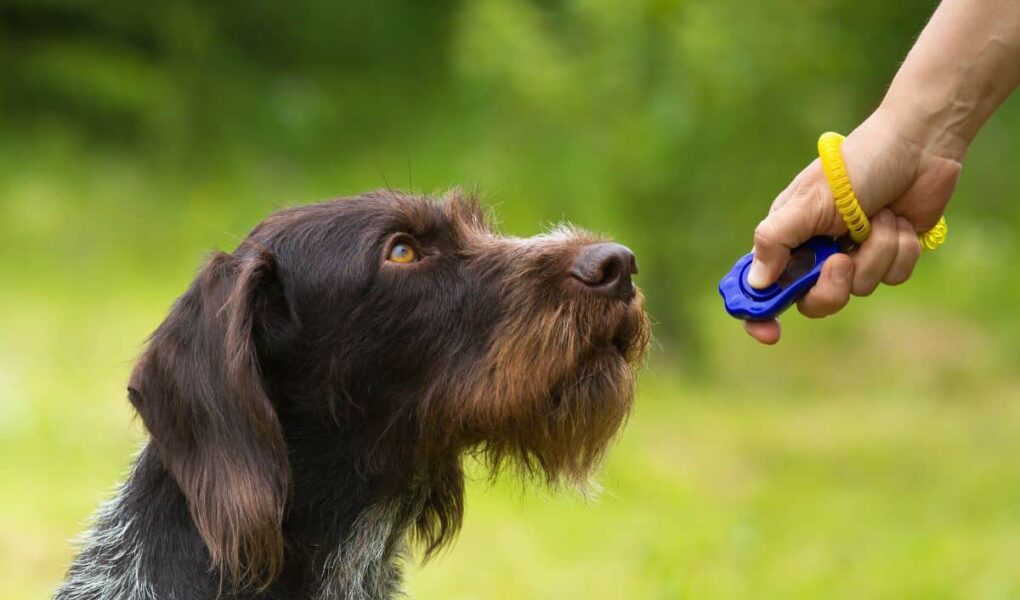Key Takeaways:
- Understanding the psychology of dogs is crucial in effective dog training
- Dogs are pack animals and establishing yourself as the leader of the pack is essential
- Common behavioral issues include excessive barking and separation anxiety
- Socialization is crucial for preventing behavior problems and building confidence
- Crate training provides a safe and comfortable space for your dog
- Positive reinforcement is an effective and humane training technique
- Establishing yourself as a fair and consistent leader is important, without using force or dominance
- Clicker training is a fun and effective method for teaching complex behaviors
- Advanced obedience training involves teaching more complex commands
- Behavior modification techniques can address and correct unwanted behaviors
- Consistency and positive reinforcement are crucial for successful house training
- Gradual desensitization and counterconditioning techniques can help with separation anxiety
- Dealing with aggression requires professional help and training techniques like desensitization and counterconditioning
Understanding Your Dog’s Behavior
The Psychology of Dogs
Understanding the psychology of dogs is crucial in effective dog training. Dogs are social animals with intricate communication systems and behavior patterns. They have evolved alongside humans for thousands of years, resulting in a strong bond between dogs and their human companions. By understanding the psychology of dogs, we can better communicate and train them.
Dogs are pack animals, and their behavior is heavily influenced by their innate pack instincts. They have a natural desire to establish a hierarchy within their pack, which includes their human family members. This hierarchy is based on leadership and dominance.
As a dog owner, it’s essential to establish yourself as the leader of the pack. This means setting boundaries, providing consistent rules and expectations, and rewarding desired behaviors. By doing so, you will create a harmonious relationship with your dog and prevent behavioral problems from arising.
Common Behavioral Issues and Solutions
Every dog is unique, but there are common behavioral issues that many dog owners face. These issues can range from mild disobedience to more serious problems like aggression or separation anxiety. Understanding the underlying causes of these behavioral issues is key to addressing and resolving them.
One common behavioral issue is excessive barking. Dogs bark to communicate, but excessive barking can be a nuisance. It’s important to identify the triggers for your dog’s barking and address them appropriately. This may involve providing mental and physical stimulation, desensitization training, or using tools like bark collars as a last resort.
Another common issue is separation anxiety. Dogs are pack animals and can develop anxiety when separated from their owners. To alleviate separation anxiety, it’s important to gradually acclimate your dog to being alone, provide them with mental and physical stimulation before leaving, and create a safe and comfortable space for them.
The Importance of Proper Socialization
Socialization is one of the most crucial aspects of dog training. It involves exposing your dog to various people, animals, environments, and situations from an early age. Proper socialization helps your dog develop positive associations and confidence, which can prevent behavior problems in the future.
During the socialization process, it’s important to expose your dog to different sights, sounds, smells, and textures. This can be done through controlled interactions with other dogs and animals, visits to different environments like parks or busy streets, and introducing your dog to various people, including children, the elderly, and individuals of different ethnicities.
Positive reinforcement is key during socialization. Reward your dog for calm and confident behavior, and provide treats, praise, and playtime when they exhibit positive reactions to new experiences. It’s important to ensure that socialization is a positive and enjoyable experience for your dog.
The Fundamentals of Dog Training
Crate Training: Creating a Safe Space for Your Dog
Crate training is a valuable tool in dog training as it provides a safe and comfortable space for your dog. Crates mimic a den-like environment, which appeals to a dog’s instinctual need for a secure and cozy space.
When crate training, it’s important to introduce the crate gradually and make it a positive experience. Start by placing treats and toys in the crate to entice your dog to enter. Once your dog is comfortable entering the crate, gradually increase the time they spend inside, always rewarding them for calm behavior.
Crate training is particularly useful for house training. Dogs naturally want to keep their sleeping area clean, so they are less likely to have accidents in their crate. Use the crate as a tool for establishing a routine and teaching your dog to hold their bladder and bowels for longer periods.
Positive Reinforcement Techniques: Training with Rewards
Positive reinforcement is an effective and humane training technique that involves rewarding desired behaviors to encourage their repetition. This technique focuses on rewarding the behavior you want to see and ignoring or redirecting unwanted behavior.
When using positive reinforcement, it’s important to identify the rewards that motivate your dog. This can be food treats, praise, petting, or playtime. Rewards should be immediate and consistently provided when your dog exhibits the desired behavior.
Positive reinforcement not only strengthens the bond between you and your dog but also makes the training process enjoyable and fun for both of you. It’s important to remember to be patient and consistent, as training takes time and repetition.
Establishing Leadership: Becoming the Alpha
Establishing yourself as the alpha or pack leader is crucial in dog training. Dogs are hierarchical animals and instinctively follow leaders. By establishing yourself as a fair and consistent leader, you gain your dog’s respect and cooperation.
To establish leadership, set clear boundaries, and enforce rules in a consistent manner. Use positive reinforcement to reward desired behavior and redirect or ignore unwanted behavior. Be confident, calm, and assertive in your interactions with your dog.
It’s important to note that being the alpha doesn’t mean using force or dominance-based training methods. Effective leadership is about mutual respect, trust, and understanding between you and your dog.
Advanced Training Techniques
Clicker Training: A Fun and Effective Method
Clicker training is a popular and effective method of dog training that uses a clicker, a small handheld device that makes a clicking sound when pressed. The clicker acts as a marker to indicate to your dog that they have performed the desired behavior correctly.
Clicker training is based on the principles of operant conditioning, where behaviors are shaped through positive reinforcement. The clicker marks the exact moment your dog performs the desired behavior, and a reward is given immediately after the click.
This technique is particularly useful for teaching complex behaviors and tricks as it allows for precise timing and clear communication between you and your dog. It’s important to pair the clicker with rewards that are highly motivating for your dog, such as small food treats or favorite toys.
Advanced Obedience Training: Teaching Complex Commands
Once your dog has mastered basic obedience commands like sit, stay, and come, you can move on to advanced obedience training. This involves teaching your dog more complex commands and behaviors.
Some advanced obedience commands include heel, where your dog walks calmly by your side; leave it, where your dog learns to ignore tempting objects or food; and off, where your dog learns to get off furniture or people on command.
Advanced obedience training requires patience, consistency, and a strong foundation in basic obedience. Break down the desired behavior into small steps and use positive reinforcement to reward your dog for gradually achieving each step. Remember to practice in various environments and gradually increase distractions to ensure your dog’s reliability.
Behavior Modification: Correcting Unwanted Behaviors
Behavior modification is the process of addressing and correcting unwanted behaviors in dogs. This could include aggression, fearfulness, or destructive behaviors.
It’s important to identify the underlying cause of the unwanted behavior before implementing behavior modification techniques. This may involve consulting with a professional dog trainer or behaviorist to develop an appropriate plan.
Behavior modification often involves a combination of management strategies, training exercises, and desensitization and counterconditioning techniques. The goal is to change your dog’s emotional response to the triggering stimulus and replace the unwanted behavior with a more desirable one.
Solving Common Training Issues
House Training Tips and Tricks
House training, also known as potty training, is one of the first and most important training exercises for a new puppy or a dog that has not been properly trained. It involves teaching your dog to eliminate outside in an appropriate area.
Consistency and positive reinforcement are key to successful house training. Establish a regular feeding and bathroom schedule, and take your dog outside to their designated bathroom area frequently. Reward your dog with praise and treats immediately after they eliminate in the appropriate spot.
If accidents happen indoors, it’s important to clean the area thoroughly to remove any residual odor that may encourage your dog to eliminate in the same spot again. Avoid punishment or scolding your dog for accidents, as this can hinder the house training process.
Dealing with Separation Anxiety
Separation anxiety is a common behavioral issue in dogs that can manifest as excessive barking, destructive behavior, or house soiling when the owner is away. It’s important to address separation anxiety to ensure your dog’s well-being and prevent damage to your home.
Gradual desensitization and counterconditioning techniques can be effective in treating separation anxiety. Start by desensitizing your dog to pre-departure cues, such as picking up keys or putting on shoes, without actually leaving. This helps your dog break the association between these cues and your departure.
Counterconditioning involves creating positive associations with being alone through activities like puzzle toys or stuffed Kongs filled with treats. Start with short periods of alone time and gradually increase the duration, always rewarding your dog for calm behavior.
Addressing Aggression Problems with Your Dog
Dealing with aggression in dogs can be challenging and requires careful management and training. Aggression can be directed towards humans or other animals and can manifest as growling, lunging, or biting.
If you are dealing with aggression, it’s important to consult with a professional dog trainer or behaviorist who has experience in dealing with aggressive behavior. They will be able to assess the underlying causes of aggression and develop an appropriate training plan.
Training techniques for aggression may include desensitization and counterconditioning, teaching alternative behaviors, using positive reinforcement, and ensuring consistent and clear communication between you and your dog.
In conclusion, dog training is a complex and rewarding endeavor that requires a deep understanding of your dog’s behavior, effective training techniques, and patience. By understanding the psychology of dogs, addressing common behavioral issues, and using positive reinforcement techniques, you can unlock your pup’s full potential. Advanced training techniques like clicker training and behavior modification can further enhance your dog’s training. Remember to address common training issues like house training and separation anxiety with patience and consistency. And when dealing with aggression, seek professional help to ensure the safety of both your dog and those around them. With dedication and knowledge, you can transform your dog into a well-behaved and happy companion.
FAQ
Question: What is the importance of understanding a dog’s psychology in training?
Answer: Understanding a dog’s psychology is crucial in effective dog training as it allows for better communication and training methods based on their pack instincts and hierarchy needs.
Question: How can I establish myself as the leader of the pack?
Answer: To establish yourself as the leader of the pack, it is important to set boundaries, provide consistent rules and expectations, and reward desired behaviors. This creates a harmonious relationship and prevents behavioral problems.
Question: What are some common behavioral issues in dogs?
Answer: Some common behavioral issues in dogs include excessive barking and separation anxiety. These issues can be addressed through proper training methods and understanding the underlying causes.
Question: What is socialization and why is it important?
Answer: Socialization is the process of exposing your dog to various people, animals, environments, and situations. It is important as it helps prevent behavior problems and builds confidence in your dog.
Question: How can I crate train my dog?
Answer: Crate training is done gradually by introducing the crate as a positive space, placing treats and toys inside to entice your dog, and gradually increasing their time spent inside. It is particularly useful for house training and creating a routine.
Question: What is positive reinforcement and how does it work?
Answer: Positive reinforcement is a training technique that involves rewarding desired behaviors to encourage their repetition. This technique focuses on rewards such as treats or praise immediately after the desired behavior is exhibited.
Question: How can I become a fair and consistent leader without using force or dominance?
Answer: Effective leadership is about mutual respect, trust, and understanding between you and your dog. It involves setting clear boundaries, enforcing rules consistently, and using positive reinforcement rather than force or dominance-based methods.
Question: What is clicker training and how does it work?
Answer: Clicker training is a method that uses a handheld device that makes a clicking sound when pressed. The clicker marks the exact moment your dog performs the desired behavior, and a reward is given immediately after the click. It is useful for teaching complex behaviors and tricks.



